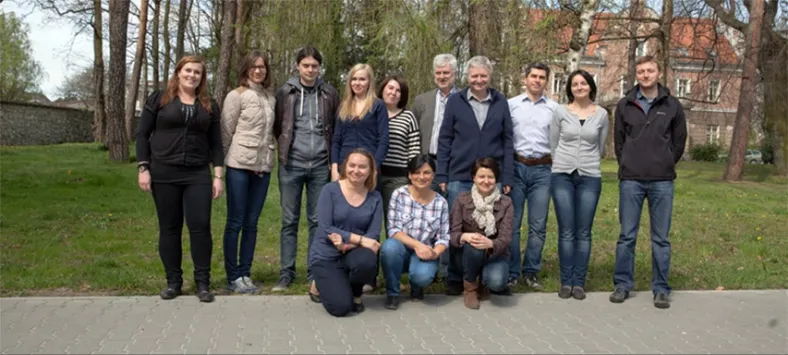Department of Neurobiology

Scientific profile
- About department
- Employees
- Laboratories
The Department of Neurobiology consists of separate research teams and the independent Laboratory of Trace Elements Neurobiology. Research teams conduct complementary studies in areas such as metabotropic receptors for glutamate and the search for new sites of action for psychotropic drugs.
The team consisting of the following members: dr hab. Agnieszka Pałucha-Poniewiera (PhD), Karolina Podkowa (MPharm) and Szymon Rzeźniczek (MSc) takes part in the study of potential antidepressant properties of glutamate metabotropic ligands and their mechanisms of action.
The team consisting of the following members: Piotr Brański (PhD), Grzegorz Burnat (PhD), Paulina Chorobik (PhD), Marcin Marcinak (PhD), Barbara Chruścicka (MSc) deals with an identification and pharmacodynamic characteristics of biologically active chemical compounds. Their studies are focused on metabotropic receptors, in particular mGluR and GABA B.
The methodology and experimental procedures
- Mammalian cell cultures
- Analysis of protein expression using RT-PCR and Western Blot
- Immunofluorescence (microscopy and FACS)
- Measurement of metabotropic receptors-mediated GTPase activity in isolated cell membranes
- Cyclic ATP measurement (cells, tissue sections) using HTRF
- Kinetic luminometric measurement of intracellular cAMP levels using a molecular sensor (Glo)
- Measurement of the IP1 accumulation (cells, tissue sections) using HTRF
- Measurement of intracellular mobilization of calcium ions (fluorescence)
- Molecular cloning (propagation of bacterial vectors, modification of DNA sequence, transfer into mammalian cells [including tetracycline-inducible gene expression system], selection of cell clones)
- Point mutations
- Experiments on transgenic animals (PCR, electrophoretic separation of products)
- Evaluation of sperm quality parameters (evaluation of: motility, vitality – eosinophilic test, maturity – presence and location of cytoplasmic droplets, integrity of cytoplasmic membrane – hyposmotic test and morphology of spermatozoids)
Dr hab. Joanna Wierońska (PhD), Monika Woźniak (MSc) and Paulina Cieślik (MSc) form a team whose main research direction are antipsychotics and their mechanisms of action. We use animal models of positive, negative and cognitive symptoms as well as techniques to determine the level of specific proteins and mRNA. Our studies oscillate around metabotropic receptors for glutamate and GABA B receptors.
The Laboratory of Neurodegeneration and Neuroprotection (no formal status), whose members are prof. dr hab. Maria Śmiałowska and Dr. Helena Domin, is involved in:
- Research on neurodegeneration and neuroprotection in experimental models of ischemia
- Study of neuroprotective and antidepressant mechanisms of glutamate group III receptor ligands and neuropeptide Y receptor ligands
- Study of anatomical and histochemical interactions between different types of neurons and astrocytes in the cerebral cortex and limbic structures. We pay special attention to GABA and NPY neurons.
Methods used
- Histology (Nissl, HE, Kluver-Barrera staining)
- Histochemistry and immunohistochemistry (NPY-ir, GAD67-ir, GFAP-ir, CRF-ir, NeuN-ir, TH-ir, TrpH-ir, immunohistochemical staining of selected receptors, and others)
- Stereological quantification in microscopic images
- Intracerebral administration of substances
- Behavioral observations and tests
- Western blot analysis of selected proteins or peptides.
The team closely collaborates with Laboratories of the Department of Neurobiology and other researchers in the Institute, especially in the field of behavior, Western blotting, neural cell cultures, and assessment of neurodegenerative changes in Parkinson’s disease models.
The Department also conducts studies regarding the anxiolytic activity of drugs and the mechanisms of action of these compounds.
Employees
Agnieszka Pałucha-Poniewiera, dr hab.
Joanna Wieronska, dr hab.
Professor Gabriel Nowak, dr hab.
Professor Andrzej Pilc, dr hab.
Professor Maria Śmiałowska, dr hab.
Helena Domin, dr hab.
Bartłomiej Pochwat, dr
Anna Rafało-Ulińska, dr
Katarzyna Stachowicz, dr hab.
Dorota Bederska-Łojewska, dr
Piotr Brański, dr
Grzegorz Burnat, dr
Barbara Chruścicka-Smaga, dr
Łukasz Gąsior, dr
Michał Santocki, dr
Yana Babii, mgr
Agata Machaczka, mgr
Employees
Achievements
- Publications
- Grants
- Awards
Grant
Involvement of cyclooxygenase 2 in antidepressant-like effects of metabotropic glutamatergic receptors group I. Grant: SONATA 7 NCN
Katarzyna Stachowicz, PhD
Grant
Narodowe Centrum Badań i Rozwoju 2012 – 2017 - jako kierownik zadania „Farmakodynamika”, Allosterix - „Innowacyjne terapie chorób neurodegeneracyjnych i neurorozwojowych w oparciu o modulatory allosteryczne receptorów mGlu.” Umowa: PBS1/B7/8/2012
dr M. Nowak - Selvita
Grant
2010 - 2014 - jako wykonawca, Nr POIG.01.01.02-12-004/09-00, Działanie: 1.1, Poddziałanie 1.1.2., DeMeTer - „Depresja – mechanizmy – terapia”.
prof. dr hab. K. Wędzony
Grant
2009 - 2012 - jako kierownik zadania „Farmakodynamika”, Nr UDA-POIG.01.03.01-12-100/08-0, Działanie: 1.3, Poddziałanie 1.3.1., ModAll - „Modulacja allosteryczna – nowa strategia w farmakoterapii. Identyfikacja właściwości psychotropowych ligandów receptorów glutaminianergicznych III grupy.”
prof. dr hab. Andrzej Pilc
Grant
Narodowe Centrum Nauki 2013 - 2016 - jako wykonawca; Platformex - ’EXtention of academia‑based PLATFORM to antidepressant hit Discovery.’ Umowa: Pol-Nor/198887/73/2013, (realizowany wspólnie z Zakładem Biologii Medycznej Uniwersytetu w Tromso z Norwegii oraz z Zakładem Biologii Komórki Narodowego Instytutu Leków w Warszawie)
prof. dr hab. A. Bojarski
Grant
2009 - 2011 - jako wykonawca; ‘Creating an academia-based platform to discover substances acting on serotonergic or glutamatergic systems as potential new antidepressant and anxiolytic drugs.’ PNRF-103-AI-1/07 from Norway through the Norwegian Financial Mechanism within the Polish-Norwegian Research Fund, (realizowany wspólnie z Zakładem Biologii Medycznej Uniwersytetu w Tromso z Norwegii oraz z Zakładem Biologii Komórki Narodowego Instytutu Leków w Warszawie)
prof. dr hab. A. Bojarski
Grant
2009 - 2012 – jako wykonawca; projekt badawczy nr N N405 055737, „Agoniści receptorów mGlu 4, 7, 8 jako potencjalne leki przeciwdepresyjne i przeciwlękowe - interakcje z układem serotoninowym”.
prof. dr hab. A. Pilc
Grant
2009 - 2011 – jako wykonawca; projekt badawczy nr N N401 009536, „Behawioralne, funkcjonalne i anatomiczne konsekwencje czasowego bądź trwałego wyciszenia genów dla metabotropowych receptorów glutaminianergicznych grupy III. Rola w patomechanizmie i farmakoterapii leku i depresji”.
dr J. Wierońska
Grant
2008 - 2011 – jako kierownik; projekt badawczy nr N N450 184635, „Poszukiwanie nowych ligandów mGluR2 i mGluR3 i ich charakterystyka farmakologiczna”.
Instytut Farmakologii PAN w Krakowie
Grant
2006 – 2009 – jako wykonawca, Grant Fundacji na Rzecz Wspierania Rozwoju Polskiej Farmacji i Medycyny (Polfarma). 34/4/2006 „Badanie przeciwdepresyjnych własności ligandów trzeciej rodziny receptorów związanych z białkami G (GPCR) oraz ich roli w mechanizmie działania leków przeciwdepresyjnych.”
prof. dr hab. A. Pilc
Grant
2006 - 2009 – jako wykonawca, Grant KBN nr 2 P05F 019 30, "Poszukiwanie nowych ligandów receptora serotoninowego 5-HT7 o potencjalnym działaniu przeciwdepresyjnym"
dr hab. A. Bojarski
Grant
2004 - 2006 – jako wykonawca, Grant KBN 3 P05A 077 25, „Potencjalne przeciwdepresyjne własności agonistów III grupy receptorów metabotropowych dla glutaminianu”
prof. dr hab. A. Pilc
Grant
2003 – 2006 – jako główny wykonawca, Grant Fundacji na Rzecz Wspierania Rozwoju Polskiej Farmacji i Medycyny (Polfarma) nr 012/2002. „Ligandy receptorów serotoninowych 5-HT7 – potencjalne zastosowanie terapeutyczne oraz nowe narzędzia farmakologiczne”.
dr hab. A. Bojarski
Grant
2003 – 2006 – jako wykonawca, Grant KBN K058/P05/2003, „Badanie korelacji molekularnych i komórkowych w mechanizmie depresji, ze szczególnym uwzględnieniem roli czynników troficznych FGF i TGF-beta w hipokampie i ciele migdałowatym”.
dr B. Legutko
Grant
2001 - 2003 jako główny wykonawca, Grant KBN 6 P05A 118 12, „Udział kinaz białkowych w mechanizmie działania leków przeciwdepresyjnych.”
prof. dr hab. A. Pilc
Grant
2000 – 2002 – jako wykonawca, Grant KBN 4 P05A 091 17, „Wpływ antydepresantów na receptory metabotropowe grupy I dla pobudzających aminokwasów”.
prof. dr hab. A. Pilc
Grant
1999 - 2000 – jako kierownik, Grant KBN 4 P05A 037 17, “Wpływ wielokrotnych podań imipraminy na aktywność CaM-KII (kinazy II zależnej od wapnia i kalmoduliny) w gęstościach postsynaptycznych izolowanych z hipokampa mózgu szczura”.
Dr Piotr Brański
Award
L'OREAL For Women in Science
Katarzyna Stachowicz, PhD
Award
Scientific Team Award WUM
Katarzyna Stachowicz, PhD
Award
Postdoc Research position Vanderbilt University
Katarzyna Stachowicz, PhD
Acid sphingomyelinase – a regulator of canonical transient receptor potential channel 6 (TRPC6) activity
Zeitler, S., Ye, L., Andreyeva, A., Schumacher, F., Monti, J., Nürnberg, B., Nowak, G., Kleuser, B., Reichel, M., Fejtová, A., Kornhuber, J., Rhein, C., Friedland, K.
DOI: 10.1111/jnc.14823
The Possibilities of Using Chromium Salts as an Agent Supporting Treatment of Polycystic Ovary Syndrome
Piotrowska, A., Pilch, W., Czerwińska-Ledwig, O., Zuziak, R., Siwek, A., Wolak, M., Nowak, G.
DOI: 10.1007/s12011-019-1654-5
Synthesis of new 5,6,7,8-tetrahydropyrido[1,2-c]pyrimidine derivatives with rigidized tryptamine moiety as potential SSRI and 5-HT<inf>1A</inf> receptor ligands
Ślifirski, G., Król, M., Kleps, J., Podsadni, P., Belka, M., Bączek, T., Siwek, A., Stachowicz, K., Szewczyk, B., Nowak, G., Bojarski, A., Kozioł, A.E., Turło, J., Herold, F.
DOI: 10.1016/j.ejmech.2019.07.027
Antidepressant-like activity of hyperforin and changes in BDNF and zinc levels in mice exposed to chronic unpredictable mild stress
Szewczyk, B., Pochwat, B., Muszyńska, B., Opoka, W., Krakowska, A., Rafało-Ulińska, A., Friedland, K., Nowak, G.
DOI: 10.1016/j.bbr.2019.112045
Development of the 1,2,4-triazole-based anticonvulsant drug candidates acting on the voltage-gated sodium channels. Insights from in-vivo, in-vitro, and in-silico studies
Kaproń, B., Łuszczki, J.J., Płazińska, A., Siwek, A., Karcz, T., Gryboś, A., Nowak, G., Makuch-Kocka, A., Walczak, K., Langner, E., Szalast, K., Marciniak, S., Paczkowska, M., Cielecka-Piontek, J., Ciesla, L.M., Plech, T.
DOI: 10.1016/j.ejps.2018.12.018
Negative Allosteric Modulators of mGlu<inf>7</inf> Receptor as Putative Antipsychotic Drugs
Cieślik, P., Woźniak, M., Kaczorowska, K., Brański, P., Burnat, G., Chocyk, A., Bobula, B., Gruca, P., Litwa, E., Pałucha-Poniewiera, A., Wąsik, A., Pilc, A., Wierońska, J.
DOI: 10.3389/fnmol.2018.00316
The potential antidepressant action and adverse effects profile of scopolamine co-administered with the mGlu7 receptor allosteric agonist AMN082 in mice
Podkowa, K., Pilc, A., Podkowa, A., Sałat, K., Marciniak, M., Pałucha-Poniewiera, A.
DOI: 10.1016/j.neuropharm.2018.08.022
The role of glutamatergic modulation in the mechanism of action of ketamine, a prototype rapid-acting antidepressant drug
Pałucha-Poniewiera, A.
DOI: 10.1016/j.pharep.2018.02.011
Are there differences in lipid peroxidation and immune biomarkers between major depression and bipolar disorder: Effects of melancholia, atypical depression, severity of illness, episode number, suicidal ideation and prior suicide attempts
Sowa-Kućma, M., Styczeń, K., Siwek, M., Misztak, P., Nowak, R.J., Dudek, D., Rybakowski, J.K., Nowak, G., Maes, M.
DOI: 10.1016/j.pnpbp.2017.08.024
Effects of magnesium supplementation on unipolar depression: A placebo-controlled study and review of the importance of dosing and magnesium status in the therapeutic response
Ryszewska-Pokraśniewicz, B., Mach, A., Skalski, M., Januszko, P., Wawrzyniak, Z.M., Poleszak, E., Nowak, G., Pilc, A., Radziwoń-Zaleska, M.
DOI: 10.3390/nu10081014
